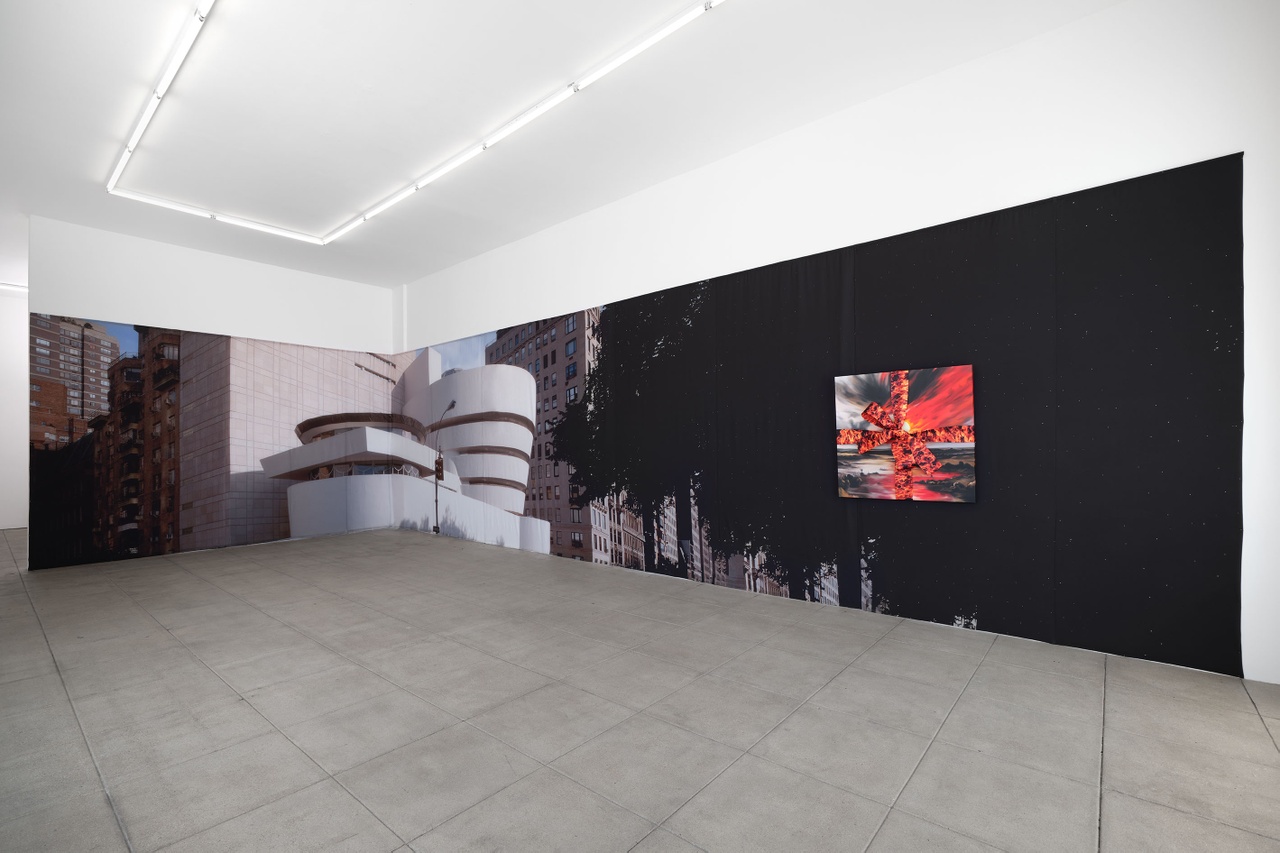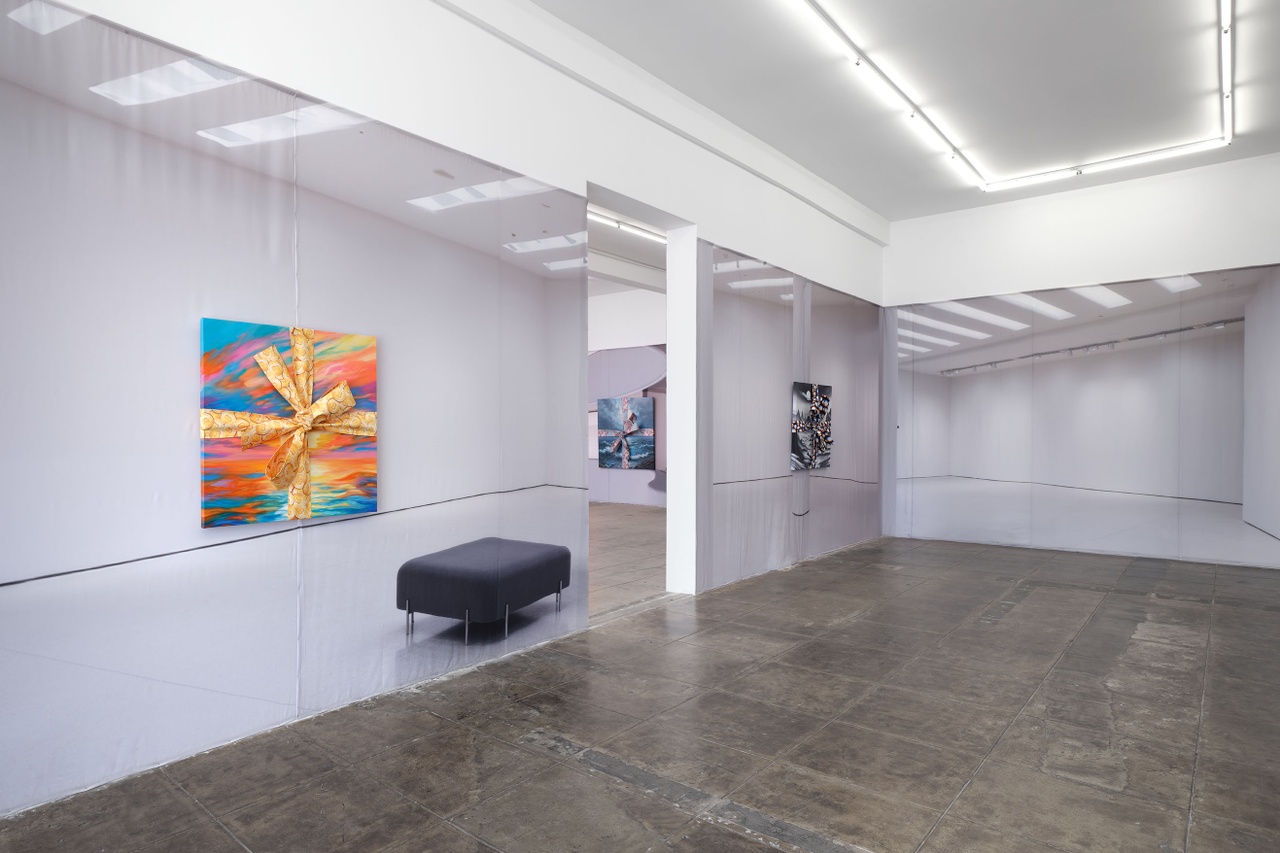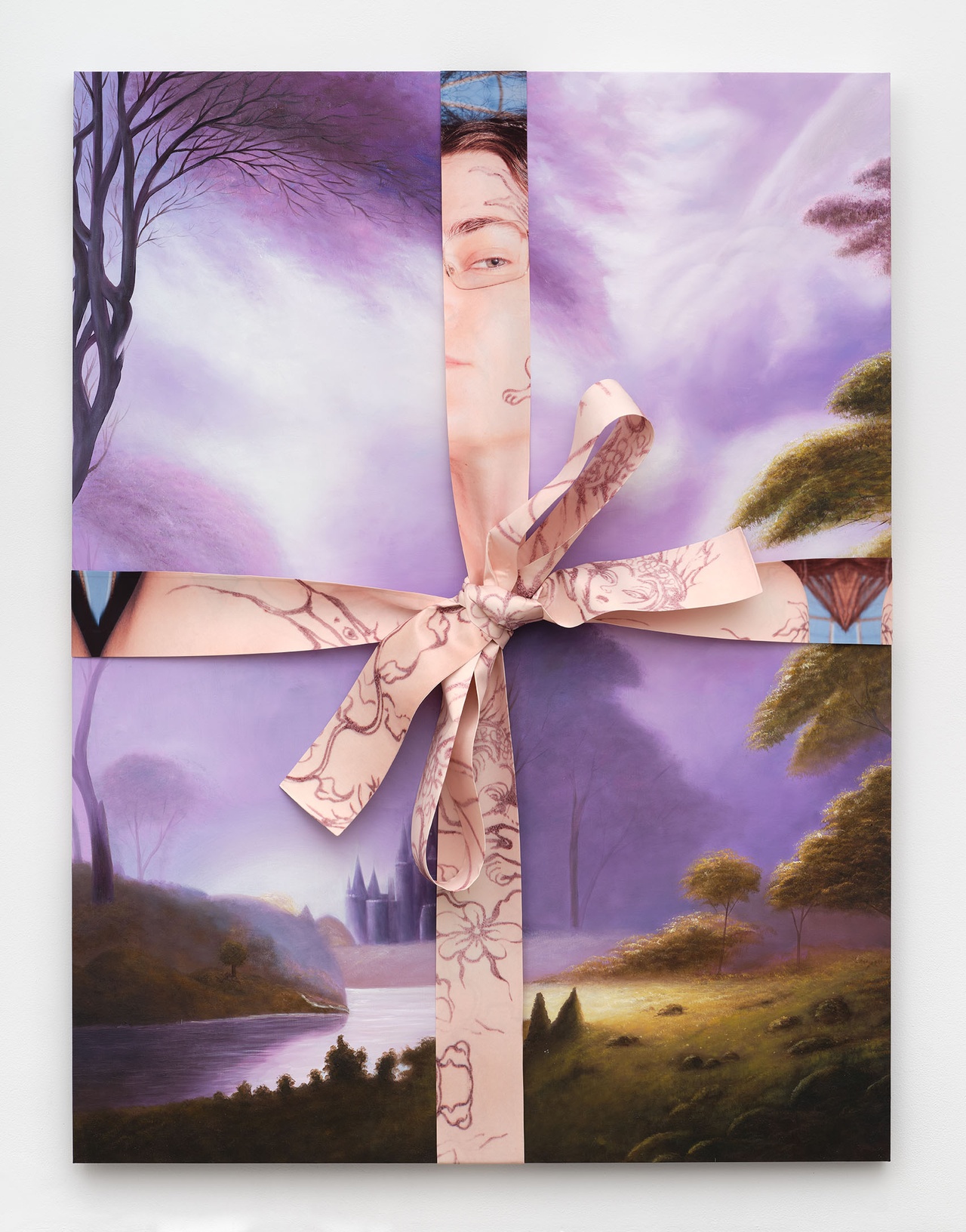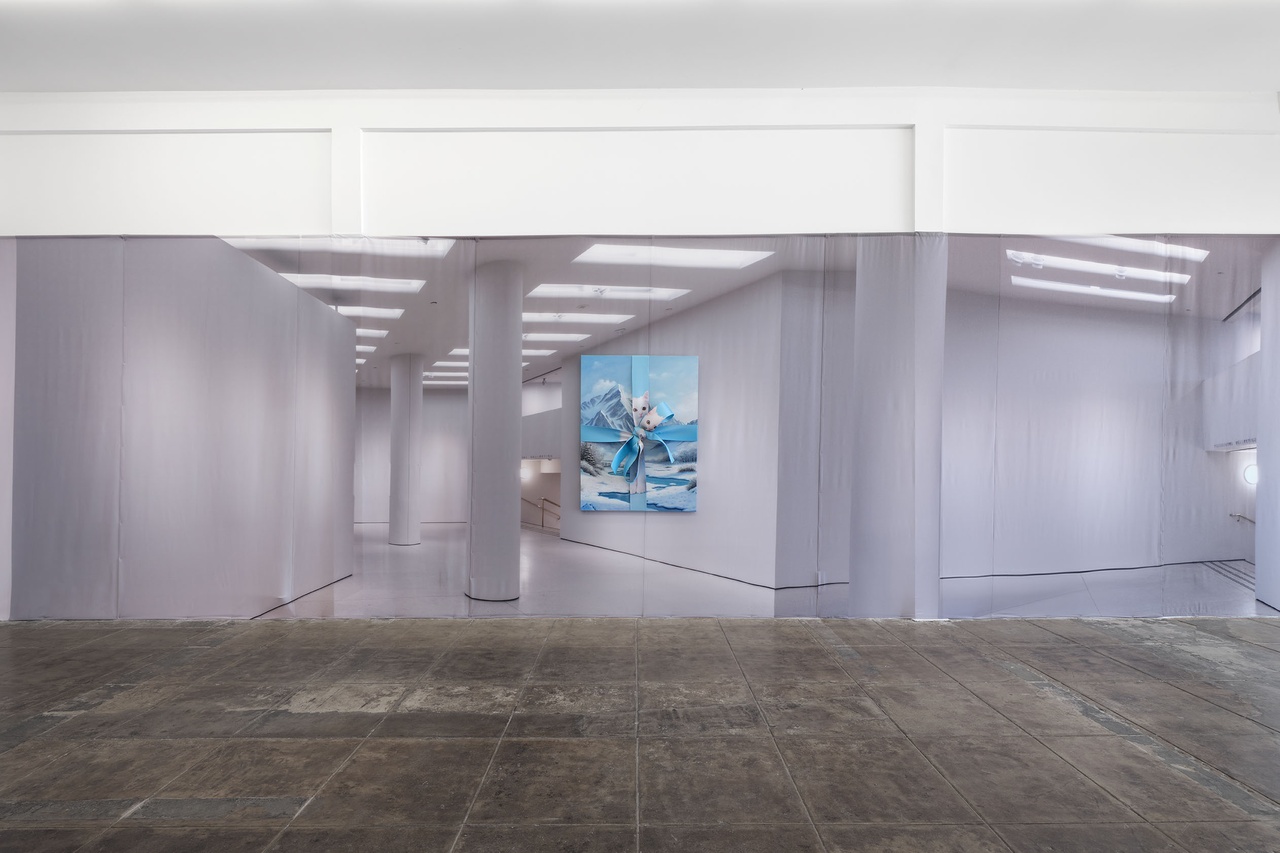THE PRETENSE OF AN ILLUSION Diva Corp on Eliza Douglas at Overduin & Co., Los Angeles

“Eliza Douglas: Guggenheim,” Overduin & Co., Los Angeles, 2025
Hardly anyone showed up to the opening of “Guggenheim,” Eliza Douglas’s latest exhibition at Overduin & Co. in Los Angeles. This was surprising: Douglas is well-known to a wider public, after all, as a recognizable and longstanding collaborator of marquee names like Anne Imhof (creator, most recently, of the titanic DOOM production at Park Avenue Armory) and Demna (Balenciaga’s acclaimed creative director, and Gucci’s next), both of whose work feasts on attention.
Perhaps, though, my expectations were too high – mid-summer competition is cutthroat in Los Angeles, especially on a Saturday. Given the choice, many locals would rather take a sunset stroll along the Walk of Fame, hunt down Justin Bieber on a Starline celeb safari, or even sip a few cocktails before sending a flaming Waymo toward the nearest police precinct. In other words, Angelenos have plenty better to do than attend an art show, and, if Douglas’s work is any indication, it seems like the artist may agree, or, at the very least, poke fun at those who think otherwise.
“Guggenheim” features eight works, all of them paintings wrapped in oversize bows. Most of them are seascape and landscape renderings (ocean chop, snow-cloaked valleys, lurid sunsets) that mimic a cheap Thomas Kinkade or souvenir painting style, composed thinly and once-over by Douglas’s assistants; [1] the bows are adorned with images – some more broadly iconic (flames, clouds, one-hundred-dollar bills), others more specific (a portrait of Douglas, a François Boucher-esque painting) – and they’re all tied at center, partially obscuring the motifs behind them. [2] Together, the works hang on gallery walls covered floor-to-ceiling with fabric depicting the recognizable ramps and halls of the Guggenheim Museum in New York, creating an illusion (or the pretense of an illusion, as we’re not exactly fooled) that Douglas’s art is “in” the Guggenheim.
The individual works are unspecific. Relating the rainbow-tinted sunrise painted in Dawn (all works 2025), for example, to the Bitcoin logos emblazoned on its bow becomes a dead-end exercise in interpretation more than anything else. One viewer could see the juxtaposition as optimism about Bitcoin’s promise of a vibrant future, another as a commentary on capitalism’s erasure of natural beauty, another as a veiled critique of the Trump administration’s recent embrace of cryptocurrency, and conceivably yet another as a metaphor for an investment approach of buy early, ride the waves, and prosper. Too wide open to be read productively, the pairing here, then, is more about its aesthetic link (the color orange), just as it is in Phenomena (gray moonlit valleys, gray anaglyph-alien-patterned bow), and in Snow (white wintry landscape, white cat-patterned bow), and in every other work in this show, for that matter.

“Eliza Douglas: Guggenheim,” Overduin & Co., Los Angeles, 2025
The Guggenheim backdrops, too, feel superficial, a crude imitation of the real thing. The fabric is synthetic, the institution’s imagery generic, the print pixelated, the tapestry’s seams glaring. It all alludes to that which is cheap, plastic, and factory-made, much like the works that hang throughout – a not-so-subtle thumbing of the nose at the close, inextricable ties between institutions and capital, and the role these play in flattening art into pure commodity.
Finally, though Douglas has repeatedly claimed that her use of painting assistants shouldn’t be such a big deal [3]– citing Rubens’s 17th-century workshop as precedent and adding that “the search for the master’s hand is a long, patriarchal-tinted practice” [4] – in the context of her work here, it is. By removing her hand altogether and having her assistants feign a kitschy and store-bought (arguably even AI-generated) [5] style, her work lives, in a sense, at least two times removed from her physical self. [6] Her hand is removed further still in Phenomena and Violet, works that replicate (or repurpose) her 2024 paintings Take Me With You and Soul, respectively, from her show “Gift” at Contemporary Fine Arts in Berlin that year. Douglas thus creates a sort of copy of a copy of a copy, albeit in slightly different dimensions and, in Violet’s case, with a different bow. This seemingly generic use of existing elements meshes neatly with the gesture of self-removal, especially given how ubiquitous Douglas and her “hand” are in the work that has come to popularly define her value – not only as a model for Demna and performer for Imhof, but also as a composer (for Imhof’s show Natures Mortes [2021], working alone and teaching herself things she “had formerly relied on others for”) [7] , and even as a costumer (in a few collaborations with Imhof, she dressed performers in clothes from her own wardrobe). [8] Building on a rather distanced, rationalized approach, “Guggenheim” plainly asserts that, within current market logics, an artist’s name and identity – their brand – outweighs more traditional forms of artistic labor (evinced quite literally in Violet, where a bow featuring Douglas’s portrait obstructs the landscape painting behind it).

Eliza Douglas, “Violet,” 2025
Taken together, the premise of “Guggenheim” is clear: Art is inconsequential (the mass-produced style, the detached authorship) save for its status as a branded commodity (the bow), which is born out of a context (the museum) that’s nothing if not fabricated (the backdrop).
If these ideas – about authorship, commodity, and context – seem unrevelatory, that’s because they are. The territory mined here has been well covered by many artists, perhaps most incisively by Merlin Carpenter, who’s been at it since the ’90s. [9] Twenty years ago, for example, in his show “A Roaring RAMPAGE of Revenge” at Reena Spaulings in New York, Carpenter repositioned his gallerists as assistants and directed them to paint “quick pseudo-abstractions” in the style of Josh Smith (whose practice, through its “signature” look and overwhelming seriality, also addresses authorship and commodity). He then overlaid Reena Spaulings press material onto those paintings and presented the works in a single stack leaned against a gallery wall, to be thumbed through like a display rack of souvenir art. [10] Put simply, Carpenter twice removed his hand to comment on the primacy of art’s context in its function as a commodity, a position that Douglas echoes in “Guggenheim” with a parallel tack. And as a side note, Douglas too has taken on Smith’s style (with the aid of assistants) in her 2019 show “Josh Smith” at Overduin and Co.
It’s also worth noting that Douglas has already repurposed her own work at a greater scale across different shows: This exhibition is effectively a combination of her 2024 show “Gift” at Contemporary Fine Arts (Berlin), which introduced the bow into her material language, and her 2022 show “THE WHITNEY BIENNIAL” at VI, VII (Oslo), which incorporated backdrops depicting the Whitney Museum in New York. Both of these shows, and most of her others, too, included paintings outsourced to other artists. Further, pointing out the bleak reality of art’s commercial drive in 2025 – as the bubble bursts on a market inflated by institutional heft – doesn’t seem prophetic or insightful so much as it seems flagrantly and undeniably true.
In fact, though, almost everything about the work seems so obvious and redundant that we must consider this effect as the point of the show, or at least a factor weighing heavily in its calculus. Far from critical and sincere, then, “Guggenheim” functions more as a meta gesture of sardonic humor. Pointing out that “art doesn’t matter” doesn’t matter, it shouts.

“Eliza Douglas: Guggenheim,” Overduin & Co., Los Angeles, 2025
And so, a bit of nihilism reveals itself, as does a penchant for self-deprecation. At the end of the day, Eliza Douglas herself is a commodity, in large part shaped by her repeated association with Imhof and Demna in the press for the past decade. To deny the vitality of those connections (and others) would be to ignore the mechanics of how art is consumed commercially. “Guggenheim” rightly, if indirectly, acknowledges that Douglas’s position – which precedes and inevitably becomes her work – is partially a product of a publicity machine designed to sell, while also making light of that fact: She’s a prepackaged commodity selling prepackaged commodities.
As for the opening … “Hardly anyone showed up? Who cares? It doesn’t matter,” the show would likely say, sure of itself, before muttering, “Just so long as the right people showed up.” Because, for this work, that does matter: Ultimately, “Guggenheim” is a one-liner told to a crowd of insiders backed by a laugh track. Yes, it takes a jab at the art world, but it does so while implicating itself and, more importantly, without undermining the apparatus – the institution – delivering a darling combination of attitude, temperance, and self-awareness. To wit, it’s innocuous: The work reiterates art’s commodity drive and grabs intellectual approval with a knowing wink. As such, it’ll enter the market, receive praise, and someday – maybe soon – we’ll see “Guggenheim” at the Guggenheim.
“Eliza Douglas: Guggenheim,” Overduin & Co., Los Angeles, June 28–August 2, 2025.
Diva Corp is an art criticism project based in Los Angeles.
Image credits: Courtesy Overduin & Co., photos SEVLAS
Notes
| [1] | In “Gift” (2024) at Contemporary Fine Arts in Berlin, Douglas used AI to generate the subject matter for her paintings, which were then painted by assistants and wrapped in bows, as they are here. Though it’s possible she used AI again in “Guggenheim,” the Overduin & Co. staff were reluctant to speak on it, and the exhibition text makes no mention of AI, only of “found images of digitally constructed landscapes.” If Douglas used AI, it would serve to further the currents in this piece about authorship and imitation, and art as a mass-produced commodity. |
| [2] | The bows in “Gift” (2024) were produced in part by Balenciaga. Though it’s possible Douglas collaborated again with Balenciaga on the bows in “Guggenheim,” Overduin & Co. makes no mention of it. |
| [3] | “We Turn in the Night, Consumed by Fire,” Eliza Douglas and Florence Bonnefous in conversation with Linnéa Bake, Air de Paris. |
| [4] | Eliza Douglas interviewed by Oliver Zahm, Purple Magazine no. 37 , 2022. |
| [5] | See footnote 1. |
| [6] | Isabelle Graw refers to Douglas’s move as a “double delegation” in her discussion of “Gift” (2024) in her online column “Seen & Read,” Texte zur Kunst, May 10, 2024. |
| [7] | “EX/INTROVERT,” Eliza Douglas in conversation with Catherine Wood, Shadowplays, April 2022. |
| [8] | “The Garbs of Doom,” Eliza Douglas in conversation with Ruby J. Thelot, SSense, March 30, 2025. |
| [9] | Carpenter worked as an assistant to Martin Kippenberger, whose work was recently the subject of a German court ruling that named a hired artist as legal coauthor of a piece completed in the early ’90s. Though Douglas’s work in “Guggenheim” avoids commenting on the division of labor involved in its production (and certainly doesn’t address the legality of artistic delegation), it nevertheless raises questions about the mechanics of value creation in the art world, much like the Kippenberger case does. |
| [10] | Reena Spaulings, “Merlin Carpenter: A Roaring RAMPAGE of Revenge,” November 12–December 18, 2005. |

